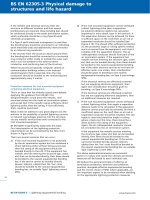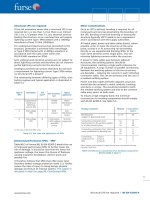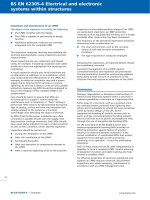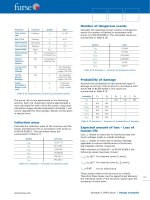Bsi bs en 01269 2015
Bạn đang xem bản rút gọn của tài liệu. Xem và tải ngay bản đầy đủ của tài liệu tại đây (917.62 KB, 12 trang )
BS EN 1269:2015
BSI Standards Publication
Textile floor coverings —
Assessment of impregnations
in needled floor coverings by
means of a soiling test
BS EN 1269:2015
BRITISH STANDARD
National foreword
This British Standard is the UK implementation of EN 1269:2015.
It supersedes BS EN 1269:1997+A1:2007 which is withdrawn.
BSI, as a member of CEN, is obliged to publish EN 1269 as a British
Standard. However, attention is drawn to the fact that during the
development of this European Standard, the UK committee voted
against its approval as a European Standard.
When EN 1269 was at the prEN formal vote stage the UK committee
voted against it because they considered that a precision clause was
needed, i.e. a clause providing any available interlaboratory trial
results obtained comparing methods A and B.
The UK participation in its preparation was entrusted to Technical
Committee PRI/3, Textile floor coverings.
A list of organizations represented on this committee can be
obtained on request to its secretary.
This publication does not purport to include all the necessary
provisions of a contract. Users are responsible for its correct
application.
© The British Standards Institution 2015.
Published by BSI Standards Limited 2015
ISBN 978 0 580 83194 2
ICS 59.080.60
Compliance with a British Standard cannot confer immunity from
legal obligations.
This British Standard was published under the authority of the
Standards Policy and Strategy Committee on 31 December 2015.
Amendments/corrigenda issued since publication
Date
Text affected
BS EN 1269:2015
EN 1269
EUROPEAN STANDARD
NORME EUROPÉENNE
EUROPÄISCHE NORM
November 2015
ICS 59.080.60
Supersedes EN 1269:1997
English Version
Textile floor coverings - Assessment of impregnations in
needled floor coverings by means of a soiling test
Revêtements de sol textiles - Évaluation des
imprégnations des revêtements de sol aiguilletés au
moyen d'un essai d'encrassement
Textile Bodenbeläge - Beurteilung von
Ausrüstungsmitteln in Nadelvliesbelägen durch die
Anschmutzneigung
This European Standard was approved by CEN on 26 September 2015.
CEN members are bound to comply with the CEN/CENELEC Internal Regulations which stipulate the conditions for giving this
European Standard the status of a national standard without any alteration. Up-to-date lists and bibliographical references
concerning such national standards may be obtained on application to the CEN-CENELEC Management Centre or to any CEN
member.
This European Standard exists in three official versions (English, French, German). A version in any other language made by
translation under the responsibility of a CEN member into its own language and notified to the CEN-CENELEC Management
Centre has the same status as the official versions.
CEN members are the national standards bodies of Austria, Belgium, Bulgaria, Croatia, Cyprus, Czech Republic, Denmark, Estonia,
Finland, Former Yugoslav Republic of Macedonia, France, Germany, Greece, Hungary, Iceland, Ireland, Italy, Latvia, Lithuania,
Luxembourg, Malta, Netherlands, Norway, Poland, Portugal, Romania, Slovakia, Slovenia, Spain, Sweden, Switzerland, Turkey and
United Kingdom.
EUROPEAN COMMITTEE FOR STANDARDIZATION
COMITÉ EUROPÉEN DE NORMALISATION
EUROPÄISCHES KOMITEE FÜR NORMUNG
CEN-CENELEC Management Centre: Avenue Marnix 17, B-1000 Brussels
© 2015 CEN
All rights of exploitation in any form and by any means reserved
worldwide for CEN national Members.
Ref. No. EN 1269:2015 E
BS EN 1269:2015
EN 1269:2015 (E)
Contents
Page
European foreword....................................................................................................................................................... 3
1
Scope .................................................................................................................................................................... 4
2
Normative references .................................................................................................................................... 4
3
Principle ............................................................................................................................................................. 4
4
4.1
4.1.1
4.1.2
4.2
4.2.1
4.2.2
4.2.3
4.3
4.3.1
4.3.2
4.3.3
4.3.4
Apparatus........................................................................................................................................................... 4
Method A............................................................................................................................................................. 4
Castor chair apparatus, ................................................................................................................................. 4
Soil distributor ................................................................................................................................................. 4
Method B............................................................................................................................................................. 5
Drum .................................................................................................................................................................... 5
Tetrapod ............................................................................................................................................................. 5
Driving system ................................................................................................................................................. 5
Equipment common to both methods ..................................................................................................... 6
Standard soil ..................................................................................................................................................... 6
Vacuum cleaner ............................................................................................................................................... 6
Large dimension grey scales ....................................................................................................................... 6
Apparatus........................................................................................................................................................... 6
5
5.1
5.2
5.2.1
5.2.2
Sampling and preparation of the specimens......................................................................................... 6
Sampling and selection of the specimens ............................................................................................... 6
Preparation of the specimen ....................................................................................................................... 7
Method A............................................................................................................................................................. 7
Method B............................................................................................................................................................. 7
6
Conditioning...................................................................................................................................................... 7
7
7.1
7.2
Procedure........................................................................................................................................................... 7
Method A............................................................................................................................................................. 7
Method B............................................................................................................................................................. 8
8
Expression of results...................................................................................................................................... 8
9
Test report ......................................................................................................................................................... 8
2
BS EN 1269:2015
EN 1269:2015 (E)
European foreword
This document (EN 1269:2015) has been prepared by Technical Committee CEN/TC 134 “Resilient,
textile and laminate floor coverings”, the secretariat of which is held by NBN.
This European Standard shall be given the status of a national standard, either by publication of an
identical text or by endorsement, at the latest by May 2016, and conflicting national standards shall be
withdrawn at the latest by May 2016.
Attention is drawn to the possibility that some of the elements of this document may be the subject of
patent rights. CEN [and/or CENELEC] shall not be held responsible for identifying any or all such patent
rights.
This document supersedes EN 1269:1997.
According to the CEN/CENELEC Internal Regulations, the national standards organizations of the
following countries are bound to implement this European Standard: Austria, Belgium, Bulgaria,
Croatia, Cyprus, Czech Republic, Denmark, Estonia, Finland, Former Yugoslav Republic of Macedonia,
France, Germany, Greece, Hungary, Iceland, Ireland, Italy, Latvia, Lithuania, Luxembourg, Malta,
Netherlands, Norway, Poland, Portugal, Romania, Slovakia, Slovenia, Spain, Sweden, Switzerland,
Turkey and the United Kingdom.
3
BS EN 1269:2015
EN 1269:2015 (E)
1 Scope
This European Standard specifies two methods for the evaluation of impregnations or other treatments
in needled floorcoverings by means of a soiling test.
There is no correlation known between the two soiling methods.
2 Normative references
The following documents, in whole or in part, are normatively referenced in this document and are
indispensable for its application. For dated references, only the edition cited applies. For undated
references, the latest edition of the referenced document (including any amendments) applies.
EN 985, Textile floor coverings — Castor chair test
EN 1471:1996, Textile floor coverings — Assessment of changes in appearance
EN ISO 139, Textiles — Standard atmospheres for conditioning and testing (ISO 139)
ISO 105-A02, Textiles — Tests for colour fastness — Part A02: Grey scale for assessing change in colour
ISO 565, Test sieves — Metal wire cloth, perforated metal plate and electroformed sheet — Nominal sizes
of openings
ISO 1957, Machine-made textile floor coverings — Selection and cutting of specimens for physical tests
3 Principle
In both tests a fixed quantity of standard artificial soil is scattered over the surface of the specimens
which is also subjected to the rolling action of castors or of tetrapod feet for a specified time. After
vacuum cleaning, the degree of colour change is assessed by comparing the contrast between treated
and untreated test specimens with the contrast of the grey scale.
Depending on the type of apparatus available, either method A or method B can be used.
4 Apparatus
4.1 Method A
4.1.1 Castor chair apparatus,
As described in EN 985, with a total load of 60 daN.
4.1.2 Soil distributor
The soil distributor uses two sieves, one inside and resting on the other to distribute the soil evenly on
the part of the circular specimen that is subjected to the wear action of the castors. The whole
distributor is placed vertically above the specimen with the sieves in the horizontal position.
The soil is placed in the inner sieve which is vibrated relative to the larger outer sieve thereby achieving
even distribution of the soil on the specimen below the two sieves.
The mesh size of both sieves is 0,5 mm (module 31 of ISO 565). The base of each sieve (each of which
has walls) is in the shape of a regular trapezium in order to correspond to a sector of the treated area of
the test specimen.
The outer (lower) sieve has following base dimensions:
4
BS EN 1269:2015
EN 1269:2015 (E)
— distance between the parallel sides: 220 mm;
— length of the parallel sides: 100 mm, 45 mm.
Its underside is 40 mm above the specimen.
The dimensions of the inner (upper) sieve are not specified but shall be smaller than the base sieve to
permit movement relative to the lower sieve.
4.2 Method B
4.2.1 Drum
A rigid cylindrical drum with bottom and lid shall be used. The inner diameter is (205 ± 5) mm and the
inner height of the drum is (200 ± 10) mm.
The drum is made of polyvinylchloride (PVC), with a thickness of at least 6 mm. The bottom and lid are
attached to the wall by appropriate means. The lid of the drum is preferably made of transparent
material, e.g. Polymethylmethacrylate (PMMA.).
4.2.2 Tetrapod
A tumbler consisting of a central metal sphere with four outer feet arranged in the shape of a regular
tetrahedron. Each foot is covered with a spherical polyurethane cap. In operation the tetrapod tumbles
inside the rotating drum so that the feet impact on the test specimen lining the drum.
Tetrapod specifications:
— total mass: (1 000 ± 25) g;
— angle between any two legs: 109,5°;
— length of the foot: (62 ± 2) mm;
— diameter of the foot: (47 ± 2) mm;
— length of the metal leg: 32 mm;
— diameter of the metal leg: 25 mm;
— socket depth of the foot: 20 mm;
— free standing height tetrapod: (124 ± 2) mm;
— material of the feet: polyurethane elastomer;
— hardness of the foot top: (75 ± 5) shore.
4.2.3 Driving system
The drum lies loose on rollers mounted on a support and drive shaft. The drum is prevented from
moving in its axial direction by smooth running wheels fixed between the shafts or by a suitable profile
on the rollers. It is important that the axis of the drum rotation is horizontal, which should be checked
by placing a spirit level along the upper surface of the drum when in position. The rotational frequency
of the drum shall be (50 ± 2) cycles per minute.
A counter is incorporated in the system, so that the number of rotations of the drum can be recorded.
The counter may be pre-set to stop the apparatus after a given number of revolutions.
5
BS EN 1269:2015
EN 1269:2015 (E)
NOTE
Longer driving rollers can be used to rotate a number of drums at the same time provided that all the
requirements of this standard are met.
4.3 Equipment common to both methods
4.3.1 Standard soil
The soil shall have the following composition (% by mass):
— Quartz silica: 88,30 %;
— Kaolin: 9,35 %;
— Yellow ferrous oxide: 0,20 %;
— Black ferrous oxide: 0,60 %;
— Paraffin oil: 1,55 %.
The soil shall have following colourimetric characteristics:
— L: 46,5 ± 1,5;
— a: 4,2 ± 0,3;
— b: 11,5 ± 0,5.
Since the colourimetric characteristics of the soil change with time and exposure to light, the soil shall
be kept in the dark and its colourimetric characteristics (L, a, b) shall be checked every 6 months
against the specified tolerances.
4.3.2 Vacuum cleaner
A household type apparatus shall be used, equipped with a smooth, approximately 2 500 mm2 section
nozzle having the following characteristics:
— partial vacuum = (1 900 ± 190) mm water column;
— air flow rate = (30 ± 3) dm3/s
4.3.3 Large dimension grey scales
A set of large dimension grey scales including half degrees according to ISO 105-A02.
4.3.4 Apparatus
An observation device according to Clause 5 in EN 1471:1996.
5 Sampling and preparation of the specimens
5.1 Sampling and selection of the specimens
Take a representative sample of four different coloured samples from the commercial range of the floor
covering in accordance with the methods given in ISO 1957.
6
BS EN 1269:2015
EN 1269:2015 (E)
5.2 Preparation of the specimen
5.2.1 Method A
From each sample to be examined, cut two test specimens in the shape of a quadrant having a radius of
350 mm. The edges of the quadrant are cut parallel with and at right angles to the direction of
manufacture. One of the two specimens is kept as a reference specimen for the evaluation. Mark the two
specimens with an arrow on the back (e.g. the direction of production) to permit alignment in the same
direction for assessment.
The quadrants are fixed onto the support (dimensionally stable flat plastic disk) using two strips of
double-sided adhesive tape laid overlapping the joints.
In the case of self-adhesive tiles place them on the support without any additional adhesive.
5.2.2 Method B
From each sample to be examined, cut two test specimens of (640 × 190) mm. The length is taken in the
direction of production. One of the two specimens is kept as a reference specimen for assessment, the
other one is used for the soiling test in the tetrapod-drum. Cover the long sides of this specimen with a
20 mm wide tape.
6 Conditioning
Condition the test specimens in the standard atmosphere specified in EN ISO 139, for at least 24 h.
7 Procedure
7.1 Method A
a) Clean the specimens using the vacuum cleaner (4.3.2) before placing them onto the castor chair
apparatus. Place the soil distributor above the specimen.
b) Weigh out 10 g of standard soil (4.3.1); rotate the support plate of the apparatus without lowering
the castor device; carefully put the standard soil into the inner sieve by means of a spatula, so that it
is evenly distributed over the whole surface of the sieve.
c) Vibrate the sieve so as to spread out the soil evenly over the whole surface of the specimen.
d) Lower the castor apparatus with a total loading of 60 daN until it rests on the support and then
rotate the plate 100 cycles without reversal so as to spread out the soil and make it penetrate.
e) Raise the castors and remove the specimen support from the apparatus.
f)
Clean the specimen with the vacuum cleaner (4.3.2) using a forwards and backwards motion for 5 s
in each direction. Repeat this 10 times. Examine the treated specimen and if the soil is not
distributed evenly on the specimen repeat the test with a new specimen.
g) On the same specimens a second soil treatment shall be applied. Repeat all of the operation b) to f)
by using the opposite direction of rotation in d).
h) Remove the specimens from the support and assess the colour change grade using the large grey
scale (4.3.3). Each assessor shall assess the colour change in the worst direction with the large grey
scale. For each specimen note the individual grade selected on the large grey scale.
7
BS EN 1269:2015
EN 1269:2015 (E)
7.2 Method B
a) Weigh 10 g of standard soil. The test specimens may be soiled before or after they have been placed
in the drum.
b) Distribution of soil before placing in the drum: Spread the standard soil over the specimen, so that
it is equally distributed over the whole surface of the specimen. Put the drum on its side and
carefully place the soiled test specimen in the drum. Keep the drum in the horizontal position to
prevent uneven distribution of the soil from edge to edge.
In the case of textile floorcoverings with pile, the pile lay should be placed in the opposite direction
of rotation.
c) Distribution of soil after placing in the drum: Put the drum on its side and place the specimen in the
drum. Keep the drum in the horizontal position to prevent uneven distribution of the soil from edge
to edge. Distribute the soil homogeneously over the test specimen, by rolling the drum forwards
and backwards on a level table.
d) Test: Mount the drum on the drive mechanism and set the number of revolutions at 3 000.
e) After 3 000 cycles, take the specimen out of the drum. Clean the specimen with the vacuum cleaner
(4.3.2) using a forwards and backwards motion for five seconds in each direction. Repeat this 10
times. Examine the treated specimen and if the soil is not distributed homogeneously on the
specimen repeat the test on a new specimen until a homogeneous distribution is achieved.
f)
Assessment: Remove the specimens and assess the colour change grade using the large grey scale
(4.3.3). Each assessor shall assess the colour change in the worst direction with the large grey scale.
For each specimen note the individual grade selected on the large grey scale.
8 Expression of results
Record the colour change grade of each specimen, i.e. the contrast between the tested specimen and the
reference specimen (5.2), using the grey scale (4.3.3).
Express the result by the worst assessment grade obtained from the different coloured specimens.
9 Test report
The test report shall contain the following information:
a) a reference to this standard i.e. EN 1269;
b) the method used (method A or B);
c) the colour change grade of each specimen of each colourway;
d) the result of the test according to Clause 8;
e) any deviation from this standard which may have affected the results.
8
This page deliberately left blank
NO COPYING WITHOUT BSI PERMISSION EXCEPT AS PERMITTED BY COPYRIGHT LAW
British Standards Institution (BSI)
BSI is the national body responsible for preparing British Standards and other
standards-related publications, information and services.
BSI is incorporated by Royal Charter. British Standards and other standardization
products are published by BSI Standards Limited.
About us
Revisions
We bring together business, industry, government, consumers, innovators
and others to shape their combined experience and expertise into standards
-based solutions.
Our British Standards and other publications are updated by amendment or revision.
The knowledge embodied in our standards has been carefully assembled in
a dependable format and refined through our open consultation process.
Organizations of all sizes and across all sectors choose standards to help
them achieve their goals.
Information on standards
We can provide you with the knowledge that your organization needs
to succeed. Find out more about British Standards by visiting our website at
bsigroup.com/standards or contacting our Customer Services team or
Knowledge Centre.
Buying standards
You can buy and download PDF versions of BSI publications, including British
and adopted European and international standards, through our website at
bsigroup.com/shop, where hard copies can also be purchased.
If you need international and foreign standards from other Standards Development
Organizations, hard copies can be ordered from our Customer Services team.
Subscriptions
Our range of subscription services are designed to make using standards
easier for you. For further information on our subscription products go to
bsigroup.com/subscriptions.
With British Standards Online (BSOL) you’ll have instant access to over 55,000
British and adopted European and international standards from your desktop.
It’s available 24/7 and is refreshed daily so you’ll always be up to date.
You can keep in touch with standards developments and receive substantial
discounts on the purchase price of standards, both in single copy and subscription
format, by becoming a BSI Subscribing Member.
PLUS is an updating service exclusive to BSI Subscribing Members. You will
automatically receive the latest hard copy of your standards when they’re
revised or replaced.
To find out more about becoming a BSI Subscribing Member and the benefits
of membership, please visit bsigroup.com/shop.
With a Multi-User Network Licence (MUNL) you are able to host standards
publications on your intranet. Licences can cover as few or as many users as you
wish. With updates supplied as soon as they’re available, you can be sure your
documentation is current. For further information, email
BSI Group Headquarters
389 Chiswick High Road London W4 4AL UK
We continually improve the quality of our products and services to benefit your
business. If you find an inaccuracy or ambiguity within a British Standard or other
BSI publication please inform the Knowledge Centre.
Copyright
All the data, software and documentation set out in all British Standards and
other BSI publications are the property of and copyrighted by BSI, or some person
or entity that owns copyright in the information used (such as the international
standardization bodies) and has formally licensed such information to BSI for
commercial publication and use. Except as permitted under the Copyright, Designs
and Patents Act 1988 no extract may be reproduced, stored in a retrieval system
or transmitted in any form or by any means – electronic, photocopying, recording
or otherwise – without prior written permission from BSI. Details and advice can
be obtained from the Copyright & Licensing Department.
Useful Contacts:
Customer Services
Tel: +44 845 086 9001
Email (orders):
Email (enquiries):
Subscriptions
Tel: +44 845 086 9001
Email:
Knowledge Centre
Tel: +44 20 8996 7004
Email:
Copyright & Licensing
Tel: +44 20 8996 7070
Email:









